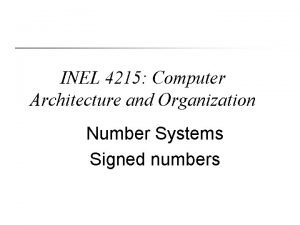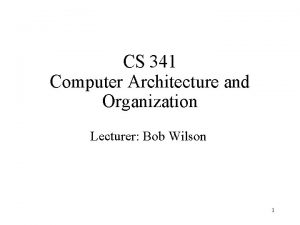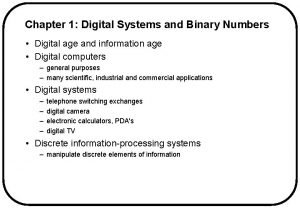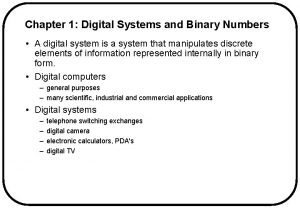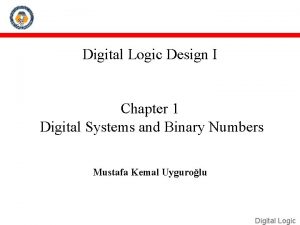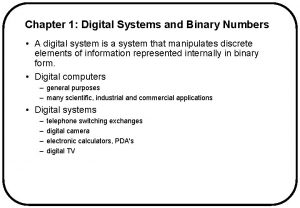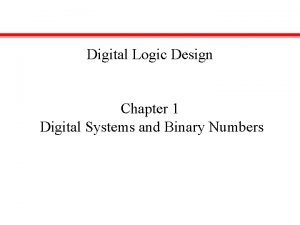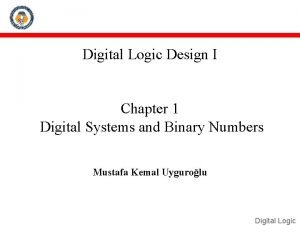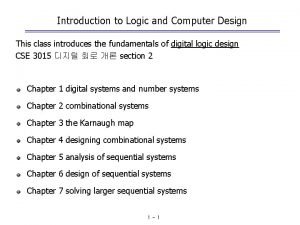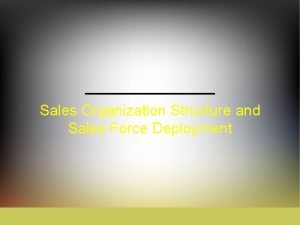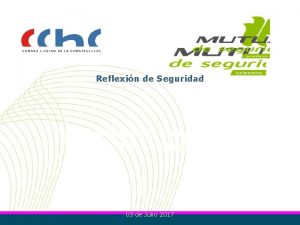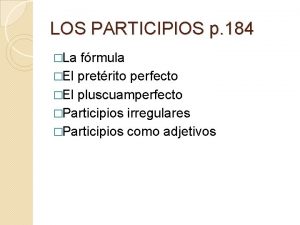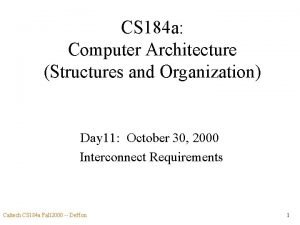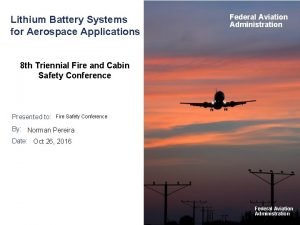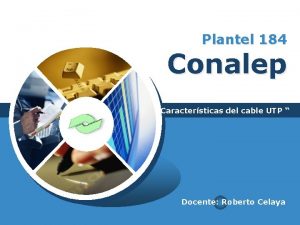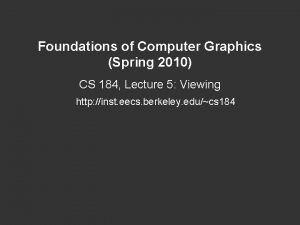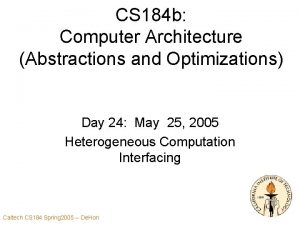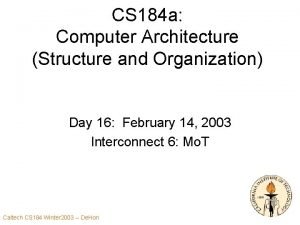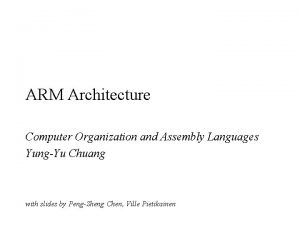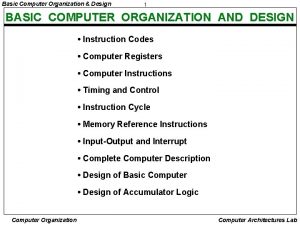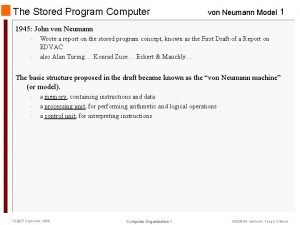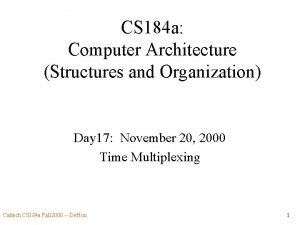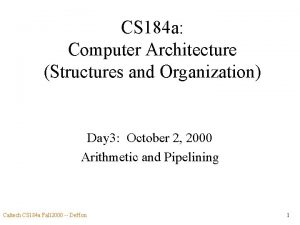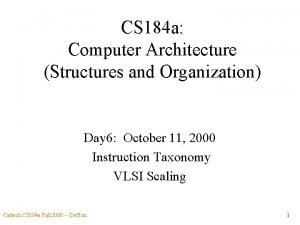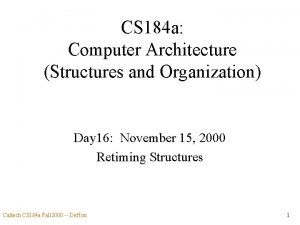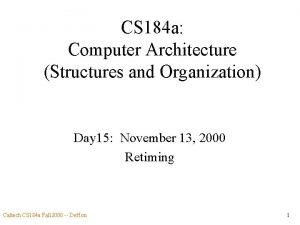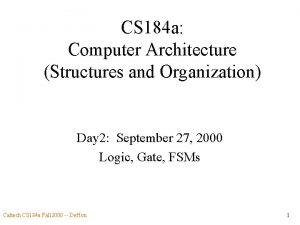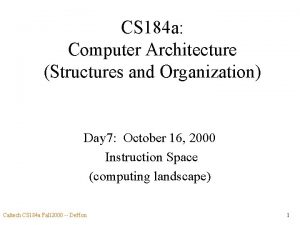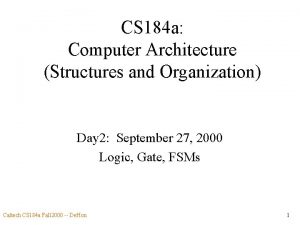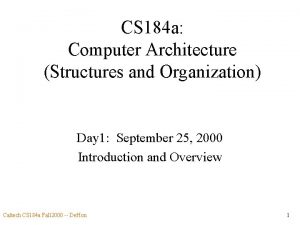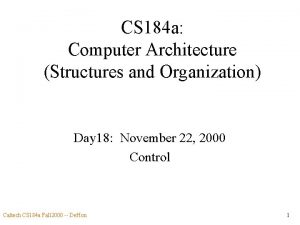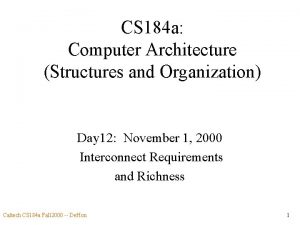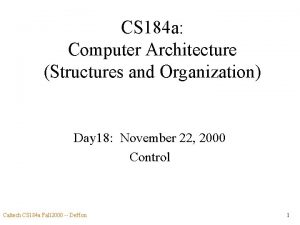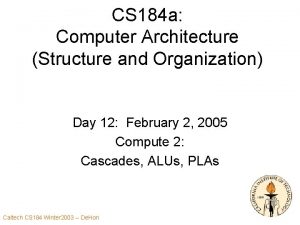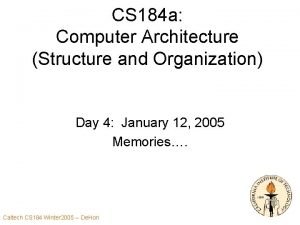CS 184 a Computer Architecture Structures and Organization
















































![Big Ideas [MSB Ideas] • Interconnect Dominant – power, delay, area • • Can Big Ideas [MSB Ideas] • Interconnect Dominant – power, delay, area • • Can](https://slidetodoc.com/presentation_image/05db3abaf5e56669bfd3833c53568c7c/image-49.jpg)
![Big Ideas [MSB Ideas] • Rent’s rule characterize locality • => Area growth O(N Big Ideas [MSB Ideas] • Rent’s rule characterize locality • => Area growth O(N](https://slidetodoc.com/presentation_image/05db3abaf5e56669bfd3833c53568c7c/image-50.jpg)
- Slides: 50

CS 184 a: Computer Architecture (Structures and Organization) Day 11: October 30, 2000 Interconnect Requirements Caltech CS 184 a Fall 2000 -- De. Hon 1

Last Time • Saw various compute blocks • Role of automated mapping in exploring design space • To exploit structure in typical designs we need programmable interconnect • All reasonable, scalable structures: – small to moderate sized logic blocks – connected via programmable interconnect • been saying delay across programmable Caltech CS 184 a Fall 2000 -- De. Hon interconnect is a big factor 2

Today • Interconnect Design Space • Dominance of Interconnect • Simple things – and why they don’t work • Interconnect Implications • Characterizing Interconnect Requirements Caltech CS 184 a Fall 2000 -- De. Hon 3

Dominant Area Caltech CS 184 a Fall 2000 -- De. Hon 4

Dominant Time Caltech CS 184 a Fall 2000 -- De. Hon 5

Dominant Time Caltech CS 184 a Fall 2000 -- De. Hon 6

Dominant Power XC 4003 A data from Eric Kusse (UCB MS 1997) Caltech CS 184 a Fall 2000 -- De. Hon 7

For Spatial Architectures • Interconnect dominant – area – power – time • …so need to understand in order to optimize architectures Caltech CS 184 a Fall 2000 -- De. Hon 8

Interconnect • Problem – Thousands of independent (bit) operators producing results • true of FPGAs today • …true for *LIW, multi-u. P, etc. in future – Each taking as inputs the results of other (bit) processing elements – Interconnect is late bound • don’t know until after fabrication Caltech CS 184 a Fall 2000 -- De. Hon 9

Design Issues • Flexibility -- route “anything” – (w/in reason? ) • • Area -- wires, switches Delay -- switches in path, stubs, wire length Power -- switch, wire capacitance Routability -- computational difficulty finding routes Caltech CS 184 a Fall 2000 -- De. Hon 10

(1) Shared Bus • Familiar case • Use single interconnect resource • Reuse in Time • Consequence? Caltech CS 184 a Fall 2000 -- De. Hon 11

Shared Bus • Consider operation: y=Ax 2 +Bx +C – 3 mpys – 2 adds – ~5 values need to be routed from producer to consumer • Performance lower bound if have design w/: – m multipliers – u madd units – a adders i simultaneous interconnection busses Caltech CS 184 a–Fall 2000 -- De. Hon 12

Viewpoint • Interconnect is a resource • Bottleneck for design can be in availability of any resource • Lower Bound on Delay: Logical Resource / Physical Resources • May be worse – dependencies – ability to use resource Caltech CS 184 a Fall 2000 -- De. Hon 13

Shared Bus • Flexibility (+) – routes everything (given enough time) – can be trick to schedule use optimally • Area (++) – kn switches – O(n) • Delay (Power) (--) – – – wire length O(kn) parasitic stubs: kn+n series switch: 1 O(kn) sequentialize I/B Caltech CS 184 a Fall 2000 -- De. Hon 14

Term: Bisection Bandwidth • Partition design into two equal size halves • Minimize wires (nets) with ends in both halves • Number of wires crossing is bisection bandwidth Caltech CS 184 a Fall 2000 -- De. Hon 15

(2) Crossbar • Avoid bottleneck • Every output gets its own interconnect channel Caltech CS 184 a Fall 2000 -- De. Hon 16

Crossbar Caltech CS 184 a Fall 2000 -- De. Hon 17

Crossbar Caltech CS 184 a Fall 2000 -- De. Hon 18

Crossbar • Flexibility (++) – routes everything (guaranteed) • Delay (Power) (-) – – • Area (-) – Bisection bandwidth n – kn 2 switches – O(n 2) wire length O(kn) parasitic stubs: kn+n series switch: 1 O(kn) Caltech CS 184 a Fall 2000 -- De. Hon 19

Crossbar • Too expensive – Switch Area = k*n 2*2. 5 Kl 2 – Switch Area/LUT = k*n* 2. 5 Kl 2 – n=1024, k=4 => 10 M l 2 • What can we do? Caltech CS 184 a Fall 2000 -- De. Hon 20

Avoiding Crossbar Costs • Typical architecture trick: – exploit expected problem structure Caltech CS 184 a Fall 2000 -- De. Hon 21

Avoiding Crossbar Costs • Typical architecture trick: – exploit expected problem structure • We have freedom in operator placement • Designs have spatial locality • =>place connected components “close” together – don’t need full interconnect? Caltech CS 184 a Fall 2000 -- De. Hon 22

Exploit Locality • • Wires expensive Local interconnect cheap 1 D versions? (explore on hmwrk) Caltech CS 184 a Fall 2000 -- De. Hon 23

Exploit Locality • • Wires expensive Local interconnect cheap Use 2 D to make more things closer Mesh? Caltech CS 184 a Fall 2000 -- De. Hon 24

Mesh Analysis • Can we place everything close? Caltech CS 184 a Fall 2000 -- De. Hon 25

Mesh “Closeness” • Try placing “everything” close Caltech CS 184 a Fall 2000 -- De. Hon 26

Mesh Analysis • Flexibility - ? – Ok w/ large w • Delay (Power) – Series switches • 1 -- n • Area – – Bisection BW -- w n Switches -- O(nw) O(w 2 n) [linear pop] larger on homework – Wire length • w-- n – Stubs • O(w)--O(w n) Caltech CS 184 a Fall 2000 -- De. Hon 27

Mesh • Plausible • …but What’s w • …and how does it grow? Caltech CS 184 a Fall 2000 -- De. Hon 28

Characterize Locality • Want to exploit locality • How much locality do we have? • Impact on resources required? Caltech CS 184 a Fall 2000 -- De. Hon 29

Bisection Bandwidth • Bisect design • Bisection bandwidth of design – => lower bound on network bisection bandwidth • Design with more locality – => lower bisection bandwidth N/2 cutsize • Enough? Caltech CS 184 a Fall 2000 -- De. Hon N/2 30

Characterizing Locality • Single cut not capture locality within halves • Cut again – => recursive bisection Caltech CS 184 a Fall 2000 -- De. Hon 31

Regularizing Growth • How do bisection bandwidths shrink (grow) at different levels of bisection hierarchy? • Basic assumption: Geometric – 1/ 2 Caltech CS 184 a Fall 2000 -- De. Hon 32

Geometric Growth • (F, )-bifurcator – F bandwidth at root – geometric regression at each level Caltech CS 184 a Fall 2000 -- De. Hon 33

Good Model? Log-log plot ==> straight lines represent geometric growth Caltech CS 184 a Fall 2000 -- De. Hon 34

Rent’s Rule • Long standing empirical relationship – IO = C*NP – 0 P 1. 0 – compare (F, )-bifurcator • = 2 P • Captures notion of locality – some signals generated and consumed locally – reconvergent fanout Caltech CS 184 a Fall 2000 -- De. Hon 35

Monday class stopped here Caltech CS 184 a Fall 2000 -- De. Hon 36

Rent’s Rule • Typically consider – 0. 5 P 0. 75 • “High-Speed” Logic P=0. 67 • Memory (P~0. 1 -0. 2) • Example (i 10) – max C=7, P=0. 68 – avg C=5, P=0. 72 Caltech CS 184 a Fall 2000 -- De. Hon 37

What tell us about design? • Recursive bandwidth requirements in network Caltech CS 184 a Fall 2000 -- De. Hon 38

What tell us about design? • Recursive bandwidth requirements in network – lower bound on resource requirements • N. B. necessary but not sufficient condition on network design – I. e. design must also be able to use the wires Caltech CS 184 a Fall 2000 -- De. Hon 39

What tell us about design? • Interconnect lengths – Intuition • if p>0. 5, everything cannot be nearest neighbor • as p grows, so wire distances Caltech CS 184 a Fall 2000 -- De. Hon 40

What tell us about design? • Interconnect lengths – IO=(n 2)P cross distance n – d. IO/dn end at exactly distance n – E(l)=Integral 0 to n= N • of n*(d. IO/dn)/n 2 • assume iid sources – E(l)=O(N(p-0. 5)) • p>0. 5 Caltech CS 184 a Fall 2000 -- De. Hon 41

What Tell us about design? • IO NP • Bisection BW NP • side length NP – N if p<0. 5 • Area N 2 p – p>0. 5 N. B. 2 D VLSI world has “natural” Rent of P=0. 5 (area vs. perimeter) Caltech CS 184 a Fall 2000 -- De. Hon 42

Rent’s Rule Caveats • Modern “systems” on a chip -- likely to contain subcomponents of varying Rent complexity • Less I/O at certain “natural” boundaries • System close – (Rent’s Rule apply to workstation, PC, PDA? ) Caltech CS 184 a Fall 2000 -- De. Hon 43

Area/Wire Length • Bad news – Area ~ O(N 2 p) • faster than N – Avg. Wire Length ~ O(N(p-0. 5)) • grows with N • Can designers/CAD control p (locality) once appreciate its effects? • I. e. maybe this cost changes design style/criteria so we mitigate effects? Caltech CS 184 a Fall 2000 -- De. Hon 44

What Rent didn’t tell us • Bisection bandwidth purely geometrical • No constraint for delay – I. e. a partition may leave critical path weaving between halves Caltech CS 184 a Fall 2000 -- De. Hon 45

Critical Path and Bisection Minimum cut may cross critical path multiple times. Minimizing long wires in critical path => increase cut size. Caltech CS 184 a Fall 2000 -- De. Hon 46

Rent Weakness • Not account for path topology • ? Can we define a “Temporal” Rent which takes into consideration? – Promising research topic Caltech CS 184 a Fall 2000 -- De. Hon 47

Finishing Up. . . Caltech CS 184 a Fall 2000 -- De. Hon 48
![Big Ideas MSB Ideas Interconnect Dominant power delay area Can Big Ideas [MSB Ideas] • Interconnect Dominant – power, delay, area • • Can](https://slidetodoc.com/presentation_image/05db3abaf5e56669bfd3833c53568c7c/image-49.jpg)
Big Ideas [MSB Ideas] • Interconnect Dominant – power, delay, area • • Can be bottleneck for designs Can’t afford full crossbar Need to exploit locality Can’t have everything close Caltech CS 184 a Fall 2000 -- De. Hon 49
![Big Ideas MSB Ideas Rents rule characterize locality Area growth ON Big Ideas [MSB Ideas] • Rent’s rule characterize locality • => Area growth O(N](https://slidetodoc.com/presentation_image/05db3abaf5e56669bfd3833c53568c7c/image-50.jpg)
Big Ideas [MSB Ideas] • Rent’s rule characterize locality • => Area growth O(N 2 p) • p>0. 5 => interconnect growing faster than compute elements – expect interconnect to dominate other resources Caltech CS 184 a Fall 2000 -- De. Hon 50
 Computer architecture and computer organization difference
Computer architecture and computer organization difference Computer organization and architecture 10th solution
Computer organization and architecture 10th solution Iit kharagpur virtual lab
Iit kharagpur virtual lab Introduction to computer organization and architecture
Introduction to computer organization and architecture Computer organization & architecture: themes and variations
Computer organization & architecture: themes and variations Computer organization and architecture 10th edition
Computer organization and architecture 10th edition Computer organization and architecture stallings
Computer organization and architecture stallings Computer organization and architecture definition
Computer organization and architecture definition One's complement
One's complement Cs341 umb
Cs341 umb Process organization in computer organization
Process organization in computer organization Buses in computer architecture
Buses in computer architecture Instruction set architecture in computer organization
Instruction set architecture in computer organization Memory organization in computer architecture
Memory organization in computer architecture Give other examples of homologous structures
Give other examples of homologous structures Basic structure of computer in computer organization
Basic structure of computer in computer organization Basic computer design
Basic computer design Flowchart for memory reference instructions
Flowchart for memory reference instructions ?3305501049 0000 28|.|091 27|.|071 98|.|553 102|.|311 13`
?3305501049 0000 28|.|091 27|.|071 98|.|553 102|.|311 13` Rh nomenclature
Rh nomenclature Binary code example
Binary code example Bcd addition of 184 and 576
Bcd addition of 184 and 576 Bcd addition of 184 and 576
Bcd addition of 184 and 576 Bcd addition of 184 and 576
Bcd addition of 184 and 576 Binary hexadecimal octal decimal table
Binary hexadecimal octal decimal table Bcd addition of 184 and 576
Bcd addition of 184 and 576 Block organization essay
Block organization essay Sales force specialization
Sales force specialization Pengertian sales force
Pengertian sales force Parallel priority interrupt
Parallel priority interrupt Articulo 184 bis codigo del trabajo
Articulo 184 bis codigo del trabajo P 184
P 184 Asl slide
Asl slide 5 sinf ona tili 329 mashq
5 sinf ona tili 329 mashq 4 184 joules
4 184 joules Cs 184
Cs 184 Cs 184
Cs 184 Ac 20-184
Ac 20-184 Conalep 184
Conalep 184 Cs 184 berkeley
Cs 184 berkeley (7 − 13) · (192 − 184).
(7 − 13) · (192 − 184). 184 bao
184 bao Tck 184
Tck 184 Art 187 lgt
Art 187 lgt Rua diogo moreira 184
Rua diogo moreira 184 Cs 184
Cs 184 Cs 184
Cs 184 Arm architecture and organization
Arm architecture and organization Computer organization and design ppt
Computer organization and design ppt Basic computer organization and design
Basic computer organization and design Modello von neumann
Modello von neumann








